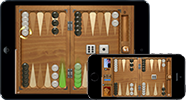Backgammon Rules
Narde Rules
Tavla Rules
Old English Rules
Nackgammon Rules
Nardegammon Rules
Backgammon is one of the oldest two player board games. Millions of people all over the world enjoy this wonderful game. Learn to play it as well!
- 30 checkers. Each player has 15 checkers of one color (white or black)
- 2 dice, these are ordinary dice with points on sides (from 1 to 6)
- doubling cube: a special cube, showing the bet of the current game
- board: the game area on which the checkers are moved according to the rules.
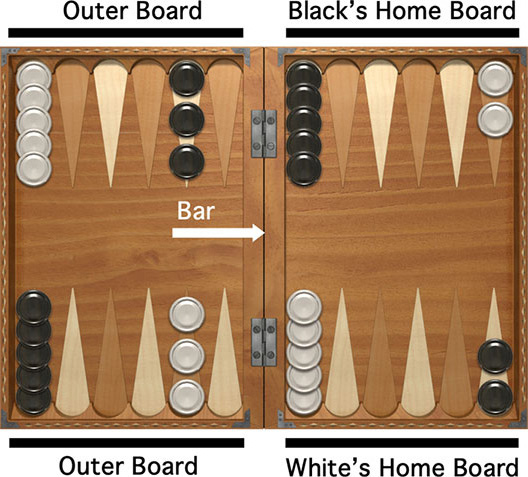
But you do not have to buy any of this as it is all already in our game!
The board is divided in four quarters, six points in each. The quarters are called – home, yard, opponent’s home and opponent’s yard. Home and yard are separated by the bar.
Beginning of the game
To determine who plays first, both players roll one dice. If the dice are the same, roll again. The player with the highest number goes first.
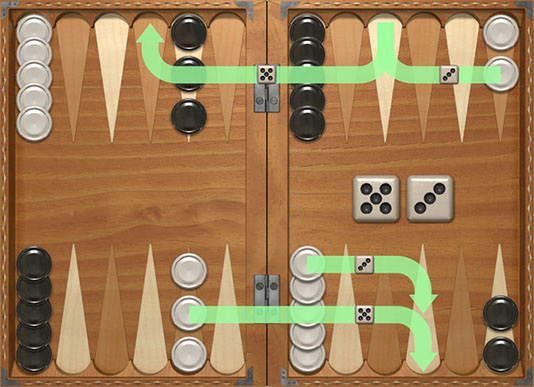
Moving of checkers
You have to move the checkers until all of them are at home. Then you have to bear the checkers off the board before your opponent does. The white checkers move counter-clockwise and the black ones – clockwise.
After the roll you have to move any checker for the specific number of times equal to the number you rolled with the dice. Afterwards you should move any checker for the number of times that you rolled with the other dice.
For example, if you rolled 3 with one dice and 5 with the other, then you can move any one of your checkers three times and another one five times. You can also move one checker eight times.
When you get an identical number of pips on both dice (double), you have to make 4 moves for the amount of pips on one dice.
If you have any hit checkers on the bar, you have to make a move with them first and then with the others. If you can not make a move with the checker on the bar, then you lose a turn. In backgammon you can place as many checkers as you like on one point. You can only place your checkers on the point if it is free or is already occupied by your checkers. If the point has one opponents checker on it, you can hit this checker.
If there is more than one checker on a point, then that checker is covered. Your opponent cannot take that point. If you are unable to move any checkers using the dice just rolled, you lose a turn. By covering six consecutive points, you can block your opponents progress. This type of play could give you an advantage and help you to win the game. You must move checkers according to the dice rolled even if you do not want to do so.You cannot skip a turn or shorten a move.
How to hit and return checkers?
In backgammon it is possible to hit opponent’s checkers. You can ony hit checkers which are not covered. In order to do this you have to move your checker on a point with an opponent’s checker that is not covered. After this move the opponent’s checker counts as hit and is placed on the bar.
Hit checkers are placed on the bar and are starting their moves from the beginning of the board. White checkers have to start from the 1st point and the black ones – from 24th. This is why the objective of each player is to hit opponent’s checkers, thus increasing the amount of necessary moves for victory.
For example, if your checker was hit and you got 6-4 pips on the dice roll, then you have to move to the fourth position. The dice 6 in this case loses, since the sixth position is taken by an opponent’s checker.
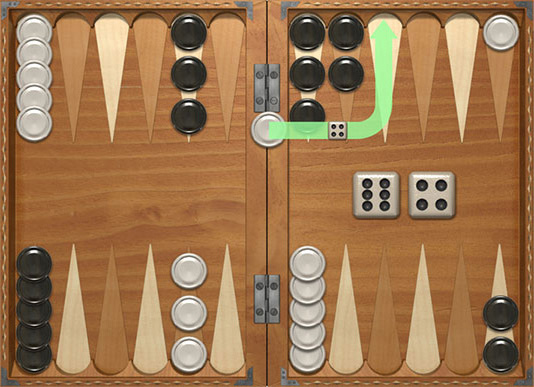
Bearing checkers off
This is possible only when all of your checkers are at home. You can bear the checkers off only from points which numbers correspond to the pips on a dice roll. For example, if you get a dice roll of 5-3, you can bear off one checker from point 5 and one from point 3.
Bearing off checkers from a point which is of lesser value than pips rolled on the dice is only possible if these points have no checkers on them. For example, you get a dice roll of 6-4, but the point 6 has no checkers, then you can bear off one checker from the point 5 and one from point 4.
The result
There is no draw in backgammon. The first player to bear off all the checkers from the board is the winner. The winner receives points which are equal to the current bet. However, if the loser has not borne off any of his checkers, he is gammoned and loses twice the value of the doubling cube. Or, worse, if the losing player has not borne off any of his checkers and still has a checker on the bar or in the winner’s home board, he is backgammoned and loses three times the value of the doubling cube.
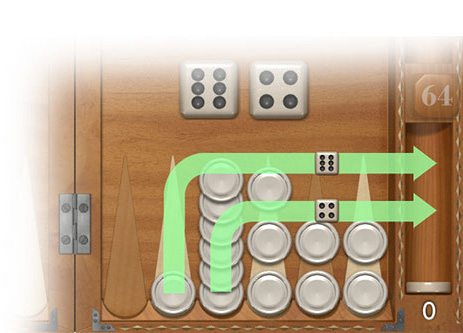
The bet
Each game begins with bet of one point. If a player feels like they are at an advantage they can offer to double the bet using the doubling cube. Players can double in the beginning of their turns before rolling the dice. If player who was offered to double declines then this player instantly loses one point. If the player accepts the game continues with doubled bets. The doubling can happen only in geometric progression (2-4-8-16 …). Player who accepted the double gains control over the doubling cube and can in turn double the bet once more.
After end of each game number on the cube indicates how many times the game result should be increased.
For example if the cube indicates “2” it means match result should also be doubled by 2.

Crawford rule
If for any of the players it takes only 1 additional point to win the match the doubling does not apply. This s the Crawford rule. In the last games of this particular match players can double with no limitations.
Crawford rule applies only in match games.
Backgammon rules in “Backgammon Masters” are implemented according to rules of US Backgammon Federation.




